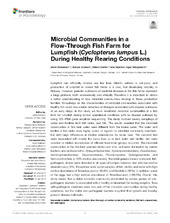| dc.description.abstract | Lumpfish can efficiently remove sea lice from Atlantic salmon in net-pens, and production of lumpfish in closed fish farms is a new, fast developing industry in Norway. However, periodic outbreaks of bacterial diseases in the fish farms represent a large problem, both economically and ethically. Therefore it is important to obtain a better understanding of how microbial communities develop in these production facilities. Knowledge on the characteristics of microbial communities associated with healthy fish could also enable detection of changes associated with disease outbreaks at an early stage. In this study we have monitored microbial communities in a fish farm for lumpfish during normal operational conditions with no disease outbreak by using 16S rRNA gene amplicon sequencing. The study involved weekly samplings of water and biofilms from fish tanks, and fish. The results revealed that the microbial communities in fish tank water were different from the intake water. The water and biofilm in fish tanks were highly similar in regards to microbial community members, but with large differences in relative abundances for some taxa. The sampled fish were associated with mostly the same taxa as in tank water and biofilm, but more variation in relative abundances of different taxonomic groups occurred. The microbial communities in the fish farm seemed stable over time, and were dominated by marine bacteria and archaea within Alphaproteobacteria, Epsilonproteobacteria, Flavobacteria, Gammaproteobacteria, Thaumarchaeota, Planctomycetes, Sphingobacteriia, and Verrucomicrobiae (>10% relative abundance). Bacterial genera known to include fish-pathogenic strains were detected in all types of sample materials, but with low relative abundances (<5%). Exceptions were some samples of fish, biofilm and water with high relative abundance of Tenacibaculum (<85.8%) and Moritella (<82%). In addition, some of the eggs had a high relative abundance of Tenacibaculum (<89.5%). Overall, this study shows that a stable microbial community dominated by various genera of non-pathogenic bacteria is associated with a healthy environment for rearing lumpfish. Taxa with pathogenic members were also part of the microbial communities during healthy conditions, but the stable non-pathogenic bacteria may limit their growth and thereby prevent disease outbreaks. | en_US |

